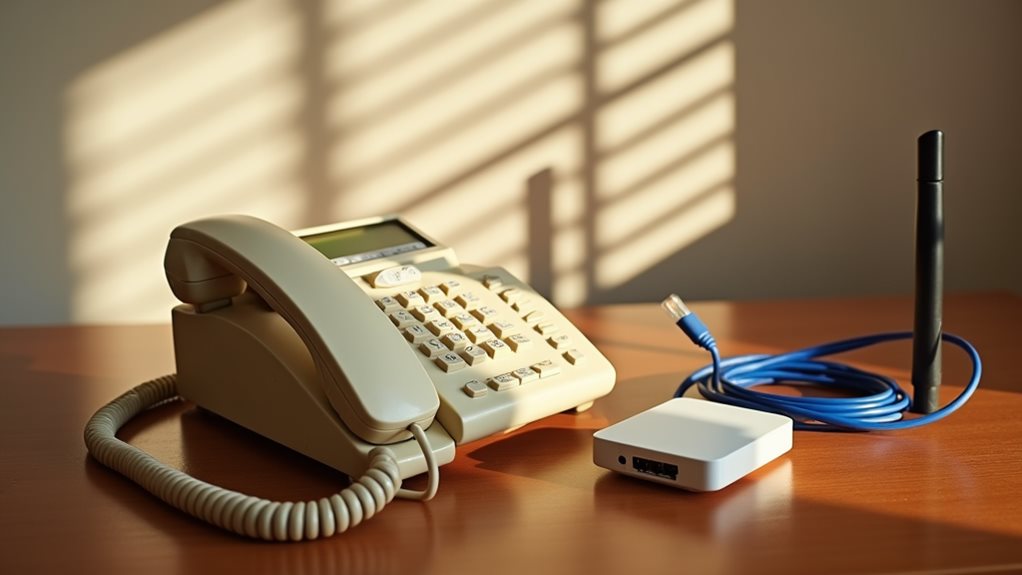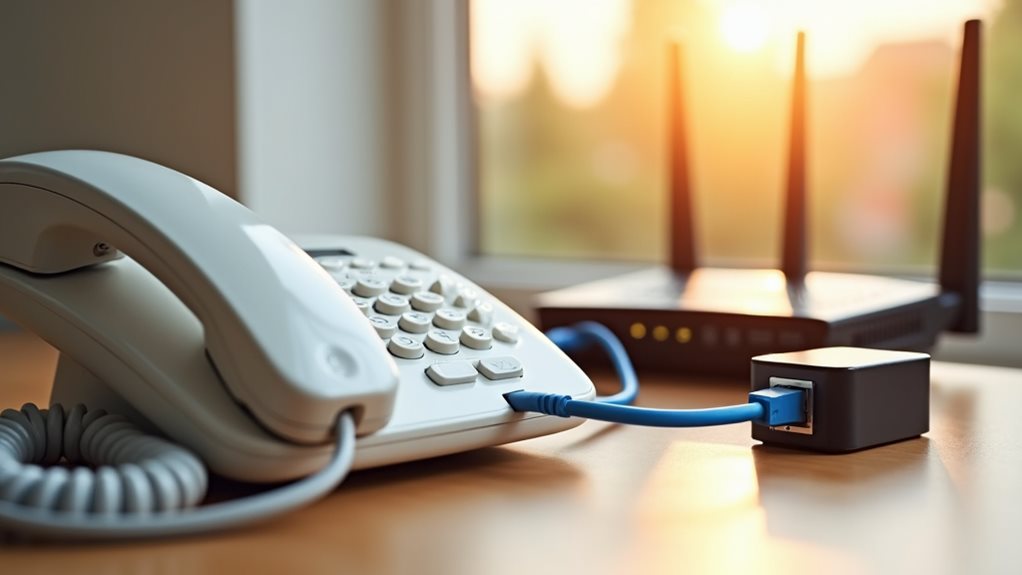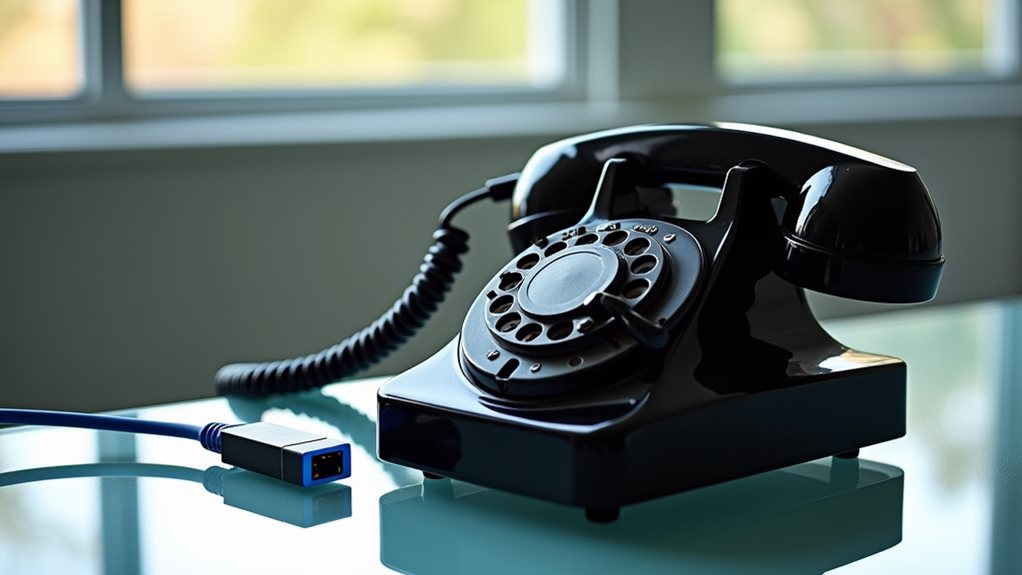Yes, you can use your existing landline phone for VoIP service by connecting it to an Analog Telephone Adapter (ATA). This small device converts your analog phone signals into digital data packets for internet transmission, fundamentally bridging your traditional phone with modern VoIP technology. You'll need a stable high-speed internet connection, a modem, router, and an ATA, with setup costs typically ranging from $100-$200. The change offers significant savings, potentially cutting your monthly phone bills by 40-60% compared to traditional service. Understanding the equipment requirements and setup process will help guarantee a successful switch to VoIP technology.
Understanding VoIP Technology
If you're considering converting your landline phone to VoIP, it's essential to understand how this technology works. Unlike traditional phone systems that rely on copper wires, VoIP transforms your voice into digital data packets that travel through the internet.
You'll find that this modern approach offers numerous VoIP benefits, including significant cost savings and enhanced flexibility in how you communicate. Modern VoIP solutions can help businesses cut monthly bills in half compared to traditional phone services. Additionally, VoIP systems provide advanced features that cater to various communication needs.
When you speak into a VoIP phone, your voice undergoes a fascinating transformation. Special software called codecs compresses your analog voice signals into digital packets, which are then transmitted across the internet. VoIP technology has made significant progress since its 1995 inception by VocalTec.
While you might encounter some VoIP challenges, such as maintaining consistent call quality during peak internet usage times, the technology has evolved to address these concerns effectively.
You'll be joining millions of others who've embraced this technology when you make the switch. The system uses protocols like SIP to establish connections and RTP to transmit your voice data, ensuring your calls connect properly.
Understanding these basics helps you appreciate how your existing landline phone can integrate into this digital ecosystem through the proper equipment and setup.
The Role of ATA
To transform your landline phone into a VoIP device, you'll need an Analog Telephone Adapter (ATA), which acts as a bridge between your traditional phone and the internet.
Setting up an ATA is straightforward: you'll connect it to both your internet router and your existing phone using standard cables, and then configure the device according to your VoIP provider's specifications. The adapter uses specialized codecs to convert analog phone signals into digital data packets for transmission over the internet. The web-based interface makes configuration simple and user-friendly even for those with minimal technical knowledge. Additionally, ensure that your home network meets VoIP requirements for optimal performance.
When choosing an ATA model, you'll want to take into account factors like the number of phone ports you need, compatibility with your VoIP service, and additional features such as fax support or built-in routing capabilities.
What ATAs Actually Do
An Analog Telephone Adapter (ATA) serves as the essential bridge between traditional analog phones and digital VoIP networks. When you speak into your landline phone, the ATA functionality converts your voice's analog signals into digital data packets that can travel across the internet. This signal conversion happens in real-time, allowing you to maintain natural conversations while benefiting from VoIP technology.
Your ATA performs several vital tasks simultaneously. It'll encode your voice, compress the data, and package it for transmission over your internet connection. The device provides a consistent dial tone to maintain familiar phone operation. When receiving calls, it reverses this process, converting incoming digital signals back into the analog format your traditional phone can understand. Additionally, ATAs help ensure Quality of Service (QoS) is maintained for the best possible voice performance. With projected growth of 1.1% in landline usage expected for 2025, ATAs continue to play a crucial role in communication systems.
You'll find that ATAs are remarkably versatile, as they can connect not only phones but also fax machines and other analog devices to your VoIP system.
The beauty of using an ATA is that you won't need to purchase new phones to join the VoIP revolution. Your existing landline phones can retain modern features like caller ID and call waiting, making the shift to VoIP both cost-effective and practical for your communication needs.
ATA Setup Requirements
Understanding your ATA setup requirements will help you make the most of your VoIP conversion. You'll need a reliable broadband internet connection and an Ethernet port on your modem or router to get started. For peak performance, you'll want to place your ATA between your modem and router, guaranteeing the best possible call quality. Upon first login to the ATA web page, a Quick Setup page will automatically appear.
Before diving into the setup, you'll need to disconnect your existing PSTN service to protect your equipment. When connecting your ATA, you'll use the RJ-11 connector for your phone and the Ethernet port for internet connectivity. This conversion can lead to cost savings of up to 40-80% compared to traditional landlines. Additionally, ensuring that your ATA is properly configured can enhance your overall VoIP communication efficiency.
Don't forget to check for ATA firmware updates before proceeding with the configuration – this confirms you're working with the latest features and security patches.
If you encounter issues during setup, here are some ATA troubleshooting tips: verify your internet connection is stable, confirm all cables are properly connected, and check that your ATA settings match your VoIP provider's requirements.
Remember to save your settings and restart the voice service after configuration. Finally, test your setup by checking for a dial tone and making a test call before fully shifting to your new VoIP system.
Choosing Compatible ATA Models
Selecting the right ATA model plays a crucial role in successfully converting your landline phone to VoIP. When you're exploring ATA features, you'll want to evaluate how many phones you'll connect and whether you need to keep a traditional phone line. Your choice should align with your specific needs, much like choosing any other essential home technology. Each FXS port allows for one telephone connection, so consider this when selecting your adapter.
The most popular ATA models, like the Grandstream HT801 and Cisco SPA122, offer reliable performance and user-friendly setups that'll make your change smoother. Model benefits vary, but you'll find that established brands typically provide better security features and regular firmware updates. Additionally, choosing an ATA from a reputable provider with strong encryption mechanisms can enhance your VoIP security. The ATA will need to convert analog signals to digital packets for transmission over the internet.
If you're planning to use fax machines or multiple phones, you'll need to pay special attention to port configurations.
Before making your final decision, check that your chosen model supports your VoIP provider's protocols and codecs. You'll also want to evaluate whether you need features like cloud management or zero-touch configuration.
Converting Landline to VoIP

Converting your traditional landline phone to VoIP requires careful planning and specific equipment. While landline limitations can be frustrating, VoIP advantages make the change worthwhile for most users. You'll need a reliable internet connection and an Analog Telephone Adapter (ATA) to begin the process.
To guarantee a smooth conversion, follow these essential steps:
- Verify your current landline account details and gather all necessary documentation
- Select a VoIP provider that supports number porting and offers the features you need
- Complete and sign the Letter of Authorization form from your new provider
- Keep your existing landline service active until the porting process is complete
- Test your new VoIP setup before canceling your old service
Once you've decided to make the switch, you'll need to maintain patience during the porting process, which can take several days or weeks depending on your provider. Additionally, this transition allows you to take advantage of advanced features and functionality that come with VoIP technology.
Remember that you're joining millions of others who've already discovered the flexibility and cost savings of VoIP technology. By using your existing analog phone with an ATA, you'll preserve the familiar feel of your home phone while gaining access to modern features and functionality.
Cost Benefits and Savings
You'll notice significant savings when switching from traditional landlines that cost around $50 monthly to VoIP services that typically range from $15-35 per line.
Your long-distance calling expenses will drop dramatically, as VoIP providers offer up to 90% savings on international calls compared to conventional landline rates.
While there's an initial investment in VoIP equipment, you'll recover these costs quickly through reduced monthly bills and the elimination of separate voice and data networks. Additionally, VoIP technology eliminates separate phone lines, which further contributes to reducing overall communication expenses.
Monthly Service Cost Comparison
When comparing monthly costs between VoIP and traditional landline services, you'll find notable price differences that can impact your budget. VoIP savings typically range from 40% to 60% compared to conventional landlines, making it an attractive option for cost-conscious consumers and businesses alike.
Let's break down the key monthly cost factors you should consider when evaluating your options:
- Basic VoIP plans start at $20-30 per user, while comparable landline services cost $20-30 per line.
- Advanced VoIP features come at $30-60 per user, versus landline premium plans at $30-48 per line.
- Volume discounts often apply when you have 20+ VoIP users, reducing per-user costs notably.
- Annual VoIP commitments can secure better rates compared to month-to-month billing.
- International calling rates are generally lower with VoIP services.
In your landline comparison, you'll notice that while base costs might seem similar, VoIP offers more features at each price point. Furthermore, VoIP technology enables significant operational cost savings by reducing expenses related to landline infrastructure.
Additionally, you won't need to maintain separate phone lines or pay for expensive infrastructure upgrades.
When you factor in the included features and reduced maintenance costs, VoIP emerges as the more economical choice for most users.
Long-Distance Calling Savings
Through VoIP technology, long-distance calling costs drop dramatically compared to traditional landline services.
You'll discover that VoIP advantages extend beyond basic connectivity, with businesses reporting up to 50% reduction in their overall phone expenses. When you're making international or cross-country calls, you won't face those hefty per-minute charges that typically come with conventional phone systems.
Your long distance savings become immediately apparent when you consider that VoIP routes calls through the internet rather than traditional phone lines.
You're joining a growing community of cost-conscious professionals – nearly one-third of businesses have already made the switch, saving an average of 32 minutes per employee daily on more efficient calls.
Whether you're running a small business or managing a large corporation, you'll appreciate that VoIP requires minimal infrastructure while delivering superior call quality.
Companies like Dell have demonstrated the substantial financial benefits, saving millions through VoIP implementation. Furthermore, many businesses experience an average savings of 60% compared to traditional systems on their first-year phone expenses when adopting VoIP technology.
The best part? You're not just saving money; you're also contributing to environmental sustainability through reduced carbon pollution while maintaining professional-grade communication capabilities that keep you connected to clients and colleagues worldwide.
Equipment Investment Benefits
Making the switch to VoIP brings considerable equipment investment benefits that can alter your communication budget.
You'll discover notable cost reductions across various equipment types while maintaining professional communication standards. The investment advantages become clear when you consider the minimal upfront costs, ranging from $100 to $200 per phone, compared to traditional systems.
Here's what you'll gain regarding equipment savings:
- Lower initial investment costs with hosted VoIP solutions
- Freedom from maintaining separate phone lines and infrastructure
- Flexibility to use existing devices like computers and tablets
- Reduced maintenance expenses through internet-based systems
- Easy scalability without considerable hardware investments
You're joining countless other businesses that have discovered the financial benefits of VoIP technology.
In addition, VoIP technology allows for seamless integration of existing systems, making the transition smoother and more efficient.
With monthly fees typically between $10 to $30 per user, you'll spend remarkably less than traditional landline services that average $50 per line.
The ability to integrate your existing analog equipment through adapters or hybrid systems means you won't have to replace everything at once, making the change more manageable and cost-effective for your organization.
Required Equipment and Setup

Setting up a landline phone for VoIP requires several essential pieces of equipment to guarantee proper functionality.
You'll need a reliable high-speed internet connection that provides sufficient bandwidth for clear voice transmission, along with a modem and router to manage your network traffic. Adapter compatibility is critical, as you'll need a VoIP adapter or gateway to convert your analog phone signals into digital data packets that can travel over the internet.
To make sure your setup works smoothly, you'll need to connect your traditional landline phone to the VoIP adapter, which then connects to your router. Internet reliability plays an important role in maintaining call quality, so it's worth investing in a stable broadband connection.
While dedicated VoIP phones are designed specifically for internet calling, your existing landline phone can work just as effectively when properly connected through the adapter.
The equipment setup process is straightforward: connect your modem to the internet service, link it to your router, attach the VoIP adapter, and finally plug in your landline phone.
This configuration allows you to enjoy modern VoIP features while using your familiar phone hardware.
Voip Vs Traditional Phone Systems
Once you've assembled the right equipment, it's important to understand how VoIP systems differ from traditional phone services. The VoIP advantages become clear when you consider how these modern systems leverage internet connectivity to deliver enhanced features and flexibility.
While traditional limitations like fixed locations and expensive hardware installations can hold your business back, VoIP technology offers a more adaptable solution that grows with your needs.
Here's what makes VoIP stand out from conventional phone systems:
- You'll enjoy significant cost savings through reduced hardware requirements and lower monthly bills
- Your team can work from anywhere, accessing their phone system with just an internet connection
- You're getting advanced features like UCaaS integration and HD voice quality
- You won't need to worry about physical line damage affecting your service
- Your system can scale easily as your business expands
The shift from traditional to VoIP technology represents a significant upgrade in how you'll handle business communications.
While traditional phones offer reliable service, they can't match the versatility and cost-effectiveness of VoIP solutions. Just remember that a stable internet connection is essential for maintaining peak call quality and preventing potential issues with latency.
Frequently Asked Questions
Can I Keep My Existing Phone Number When Switching to Voip?
Yes, you can keep your existing number through a process called porting numbers. Most VoIP providers support this changeover, but you'll need to meet specific requirements and maintain your current service during the transfer.
What Happens to Voip Service During Power Outages?
During power outages, your VoIP service won't work unless you've got power backup solutions in place. You'll need a UPS or battery backup to maintain reliability, and mobile apps can keep you connected with your team.
How Good Is Voip Call Quality Compared to Traditional Landlines?
You'll find VoIP call quality matches or surpasses landlines when you've got a strong internet connection. With modern echo reduction and high-speed internet, you're getting crystal-clear conversations just like your traditional phone service.
Does Voip Work With Home Security Systems and Fax Machines?
Yes, you can use VoIP with security systems and fax machines, but you'll need proper compatibility checks. For security system integration, guarantee backup power's available. T.38 protocol support's essential for your fax machine's reliable operation.
What Internet Speed Is Required for Reliable Voip Service?
You'll need at least 0.5 Mbps of internet bandwidth for reliable VoIP service. For the best experience, make certain your connection stability is strong, as each concurrent call uses about 90-100 kbps of bandwidth.
Final Thoughts
You can convert your landline phone into a VoIP system with minimal hassle and significant cost savings. By using an Analog Telephone Adapter (ATA) and a reliable internet connection, you'll access modern calling features while keeping your familiar handset. Whether you're running a business or managing your home communications, making the switch to VoIP offers flexibility and functionality that traditional landlines can't match.

